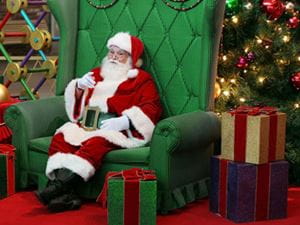
For instance:
- In 2010, Santa Claus is celebrating his 1,730th birthday! The original Nicholas was born in 280 A.D. in the small country of Lycia, which is now part of modern-day Turkey.
- Nicholas became first a priest and then a bishop in the early Christian church. The very first paintings of him show Nicholas wearing the ceremonial robes of a Christian bishop – red trimmed with white. When we see “Santa’s suit” today, we’re seeing those same colors.
- Nicholas became famous for gift-giving, usually to the poor. In the early fourth century a legend began to spread about Nicholas coming at night to the home of three poor girls who did not have dowries and therefore could not marry their fiancés. While the girls slept, Nicholas left gold coins in their stockings, which were drying by the fire. That’s how our tradition of Santa filling stockings got its start.
- Santa is known my many names all over the world. He became “Santa Claus” in America because many of the first English colonists to arrive to not celebrate Christmas; as Puritans they felt the holiday was disrespectful to Jesus. But their children saw the children of Dutch settlers receiving gifts from someone called “St. Nicholas.” They thought the gift-giver’s name was “Sinter Klass” and anglicized it further to “Santa Claus.”
- Many people think Santa’s reindeer were introduced to the holiday in Clement Moore’s wonderful poem “A Visit from St. Nicholas,” which most of us now call “’Twas the Night Before Christmas.” Moore wrote about Santa and the eight reindeer in 1822. But in 1809 another great American author named Washington Irving wrote a book titled Diedrich Knickerbocker, and in it he wrote about St. Nicholas delivering presents to children “by flying over the treetops in a wagon.” Clement Moore simply expanded on that previous description.
- The first department store Santa appeared in 1841 at J.W. Parkinson’s Dry Goods store in Philadelphia. This Santa tried to slide down a chimney to impress the children who were watching, but he got stuck halfway down.
- During the Civil War, a magazine artist named Thomas Nast began drawing cartoons of Santa as a diversion for readers from the horrors of war. He sketched Santa as living at the North Pole, and having a lot of elves as his assistants. Everyone believed that must be true.
- Mrs. Claus began appearing in Christmas lore in the late 1880s. In 1889 a poet/composer named Katharine Lee Bates wrote a poem called “Goody Santa Claus on a Sleigh Ride.” (Wives in those days were often referred to as “good wives,” or “goody” for short.) In the poem, Mrs. Claus tells Santa that she will deliver gifts that year, since it’s not fair that he gets to have all the fun. In 1910 another poem of Ms. Bates was set to music and published as a song everyone knows – America the Beautiful.
- In 1890 department store Santas began appearing all over America, especially on the East Coast around Boston. They were so popular that parents in other cities joined together and hired passenger trains to take their families to see these Santas.
- About this same time, Ralph E. Morris of the New England Telephone Company looked at switchboard lights and proposed that strings of them be hung on Christmas trees- they would be safer than candles.
- Our modern-day image of Santa as a stout man is based on Coca-Cola ads from the 1930s. Artist Hans Sundblom used as his model a retired salesman named Les Prentice.

